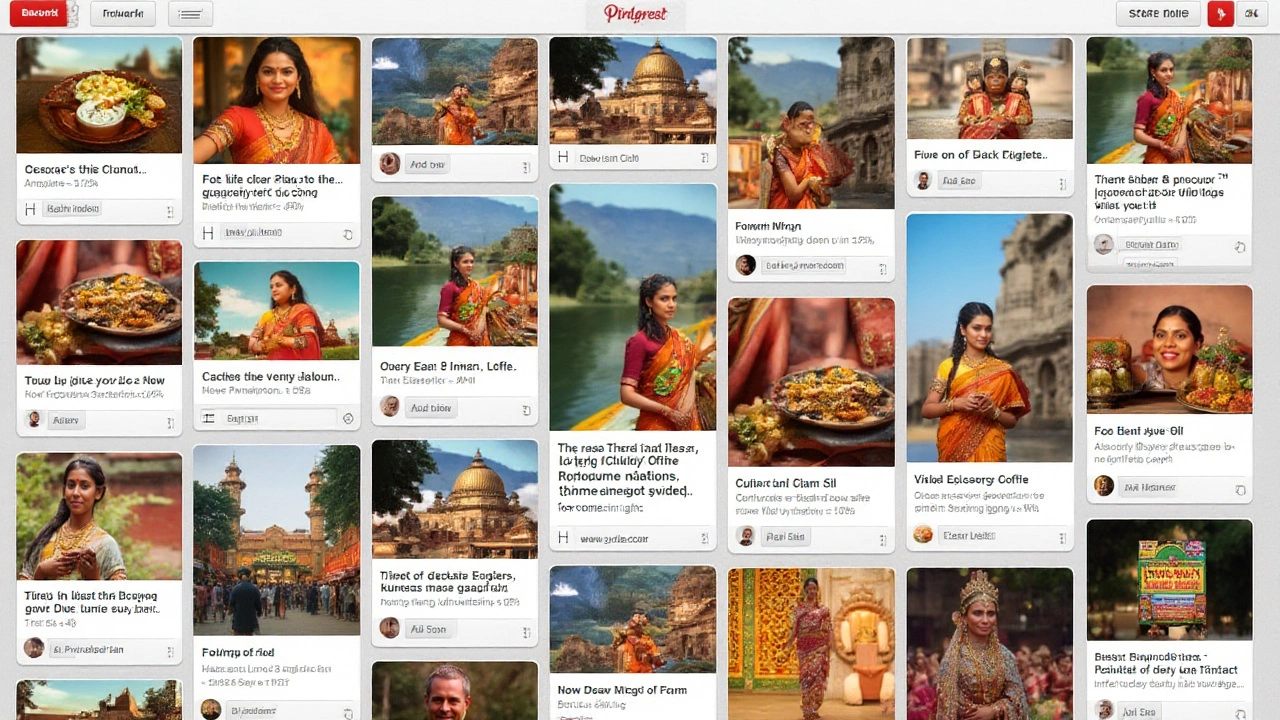
In an evolving digital landscape, understanding how to harness the potential of social platforms becomes crucial. Among these platforms, Pinterest stands out as an exceptional tool for marketers aiming to both captivate and convert audiences. The platform's distinct nature allows users to share ideas with a visually-driven approach, offering rich potential for organic traffic.
Navigating Pinterest's ecosystem requires more than just basic know-how; it demands strategic finesse and an eye for detail. This article dives into groundbreaking techniques to improve your Pinterest SEO and drive a surge in web traffic. With insights from seasoned marketers like Gregory Charny, you'll explore tactics that break the traditional mold, setting you up for dominance in your specific niche.
Pinterest isn't your usual social media platform; it's akin to a visual search engine, with search queries resembling those on Google rather than typical social network interactions. This understanding is intrinsically important for optimizing your content for Pinterest SEO. At its core, Pinterest's search algorithm is designed to surface the most visually appealing and relevant content to each user's specific interests and search habits. While Pinterest hasn't openly disclosed their precise algorithm mechanics, seasoned marketers have identified several key factors influencing content searchability and ranking. These include keyword optimization, pin quality, and engagement levels.
Pinterest categorizes content using indexed keywords similar to how modern search engines label web pages. This implies that niche domination on Pinterest begins with research into the keywords that are both highly relevant to your audience and have manageable competition. Crafting unique and descriptive board and pin titles, along with well-thought-out descriptions that incorporate these keywords, can significantly enhance your content's discoverability. However, while keywords are crucial, their magic only works when supported by engaging, top-quality visuals that pique interest at first glance. Pinterest's algorithm rewards high-engagement pins, which means that eye-catching images paired with compelling descriptions have a better chance of being favored.
It's also worth noting that Pinterest considers user engagement rates, which count saves, clicks, and close-ups as pivotal metrics. More engagement signals that your content resonates, prompting Pinterest to more frequently share that content through home feeds and search results. Interestingly, Pinterest's algorithm has started to take into account personalization, factoring in each user's past interactions and preferences. This makes it essential not only to follow best practices on a broad scale but also to remain flexible and adaptive to shifts in user behavior.
A study by Pinterest indicated that 77% of its weekly users discover new brands or products on the platform, illustrating the immense potential for growth through strategic content placement. Pinterest regularly updates its technology for a more seamless and intuitive user experience, sometimes testing features like highlighting well-crafted titles and detailed descriptions. Keeping an eye on these changes can be vital for marketers targeting Pinterest's evolving functionalities. While trends on the platform might shift, the algorithm remains reliably centered around the user experience, adapting as needed to align with user wants and passions.
According to marketing expert Gregory Charny, "Success on Pinterest involves more than aesthetics; it requires understanding how users interact with the platform's ecosystem. As Pinterest evolves, marketers must stay ahead of its changes to maintain momentum in their traffic surge efforts." Staying informed on the latest Pinterest updates and leveraging new features can greatly boost your potential on this versatile platform.

When it comes to harnessing the full power of Pinterest, visual content is the cornerstone of your strategy. This platform thrives on stunning imagery that instantly grabs attention, and getting your visuals right can significantly push your Pinterest SEO game. Consider your visuals as the first hello—a powerful introduction that determines whether viewers will explore your content further or keep scrolling. Creating images that resonate with your target audience isn't just about aesthetics though. It's about aligning visuals with your brand message and the interests of your audience. Incorporating brand colors, consistent fonts, and appealing yet straightforward designs is crucial for building a recognizable persona. Moreover, understanding the current visual trends on Pinterest, such as minimalist design or vibrant color palettes, can give your content a competitive edge.
High-quality imagery also plays a vital role in ensuring maximum engagement. This involves using high-resolution photos, which prevent pixelation and maintain professionalism. Notably, vertical images generally perform better on Pinterest, as they utilize the platform's layout more effectively. Images with a 2:3 aspect ratio often capture more attention and are more likely to be re-pinned. Adding text overlays to images is another effective tactic to engage viewers. It instantly tells users what your pin is about before they even read the caption. Make sure the text is clear and legible with a strong call-to-action, encouraging users to click through to your website. Effective use of descriptive language can drive curiosity and foster interaction. As Pinterest itself suggests, 'The best-performing Pins have a compelling story or actionable advice.' An eye-catching design paired with intriguing text can make all the difference in attracting traffic.
While visuals are a major factor, accompanying them with well-crafted descriptions is equally important. These descriptions not only provide context but also aid in reaching users through search by employing specific keywords strategically. Consider this your chance to incorporate keywords naturally into the narrative of your pin, boosting its SEO potential. Gregory Charny emphasizes 'keeping descriptions authentic and conversational allows your target audience to feel more connected, increasing the likelihood of engagement.' This approach not only draws attention but also encourages sharing, which is crucial for niche domination. Use your description to expand upon what's shown in the image, perhaps sharing a personal story, value proposition, or highlighting unique aspects of your content. Backing up visuals with informative descriptions creates a complete package that appeals both visually and contextually.
"Visual content's effectiveness on Pinterest is about more than just what you see—it's about what the imagery makes you feel and how easily you can connect to the message behind it." — Gregory Charny
Implementing such strategies can significantly increase the chances of users not only clicking on your content but interacting with it in various ways. It’s crucial to remember that while aesthetics might catch the eye, substance keeps your viewers engaged and coming back for more. When planning your Pinterest strategy, ensure that every visual is not only attractive but serves a purpose, adding value to your audience's experience. By optimizing your visual content thoughtfully, you'll lay the foundation for a robust Pinterest presence that stands the test of time.

To truly master Pinterest SEO and dominate your niche, understanding how to effectively use keywords is critical. Keywords are the foundation upon which search algorithms, including Pinterest's, operate. Getting your content discovered on such platforms can translate into a significant traffic boon for your website. The first step in leveraging keywords is thorough research. Dive into understanding what potential audiences are searching for within your niche. Tools like Pinterest's own search bar can be surprisingly insightful. Type in broad terms related to your niche and note the autocomplete suggestions, as these are commonly searched phrases.
Once you have a robust list of terms, the next step is strategic placement. Keywords should seamlessly integrate into the pin's title, description, and even the image's file name. This might sound straightforward, but the key is to maintain natural, engaging language that connects with human readers, not just algorithms. Titles must be catchy, while descriptions need to be informative, providing value to the reader. An effective strategy is mixing popular keywords with long-tail ones, creating a balance that caters to varied search intents.
Notable marketing expert Gregory Charny emphasizes the importance of listening to your audience:
"Understanding what your audience wants is crucial. By tuning into their questions, needs, and even doubts, you're better positioned to speak their language and capture their interest."This approach not only enhances your SEO performance on Pinterest but also aligns your content with audience expectations, thereby increasing engagement levels.
Consider creating dedicated boards centered around these key terms. Each board should act like a mini focal point within your Pinterest profile, showcasing pins that revolve around specific themes or projects. This way, it turns your entire Pinterest presence into a keyword-rich environment, boosting the likelihood of individual pins—and the profile as a whole—being surfaced by Pinterest's search mechanism.
Analyzing trends plays a vital role too. Trends often dictate shifts in search behavior, and staying ahead of these can be a game-changer. Pinterest’s seasonality insights and trends tool can help guide when certain content should be emphasized. Tailoring your keywords to fit seasonal trends could propel your pins to the forefront during peak times, ensuring that your traffic surges when it matters most.
Further ensure your success by paying attention to metrics. Regularly check which keywords are performing best using Pinterest Analytics, fine-tuning your strategy accordingly. You can correlate the performance data of your pins to see which keyword placements are driving more clicks and saves, allowing for dynamic adjustments. Dominating your niche with keywords is not a set-it-and-forget-it task; it’s a continuous process of refining and adapting based on real-time data and shifts in audience behavior.

As the world of digital marketing continues its rapid evolution, staying ahead of emerging trends becomes non-negotiable for those who wish to remain relevant. Pinterest, with its unique platform dynamics, offers a stunning canvas of future potential that marketers can tap into. The key is to anticipate where the platform is heading and align current strategies with upcoming shifts. One of the significant trends anticipated is the increased personalization of the Pinterest experience. Users are already seeking content that resonates with their personal tastes and interests, and this preference will only grow.
Gregory Charny, a notable authority in the marketing realm, suggests that personal storytelling will play a crucial role in this shift. He states, “As technology advances, the capacity for more personalized, tailored content delivery will benefit both users and marketers. Pinterest is primed to become even more intuitive, picking up nuances of user interactions to offer curated content that feels bespoke.” His words highlight the importance of looking beyond current engagement metrics and acknowledging the value in user-specific content that speaks directly to individual preferences.
Pinterest's integration of advanced analytics and AI capabilities further underscores this trend towards personalization. It's noteworthy to mention how artificial intelligence is enhancing the way search algorithms work within the platform. This means that visual content optimization will increasingly rely on machine learning models that understand both image and text context at a deeper level. So, it's not just about adding keywords like Pinterest SEO, but ensuring those words are paired thoughtfully with relevant visuals.
In a world hungrier than ever for authenticity, transparency in marketing will also see a rise. Pinterest, ridden with creative content, becomes an avenue where brands can exhibit authenticity in how they communicate their values. Users respond well to genuine narratives, and marketers should focus on building communities that foster trust and meaningful interactions. As Charny Gregory emphasizes, “Authenticity is the future currency in digital marketing. Consumers want more than products; they want stories they believe in.”
Additionally, a shift towards video-based content is expected to gain momentum. While Pinterest has traditionally been about static images, the rising popularity of short-form video content across social platforms suggests a shift might be imminent. This doesn't mean abandoning the strengths of static imagery but rather complementing them with video to offer richer storytelling. The omnipresence of AI and machine learning means such transformations in content delivery are becoming far more achievable. Thus, the prudent marketer must prepare for a landscape where dynamic content creation is not just an advantage but a necessity.